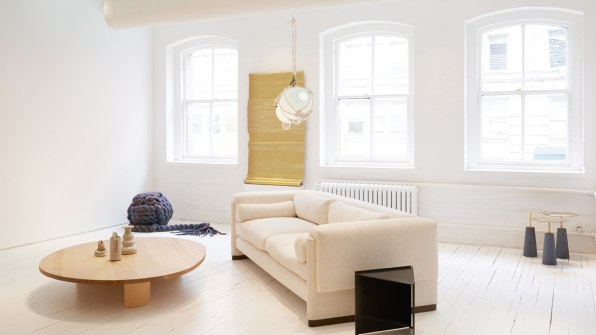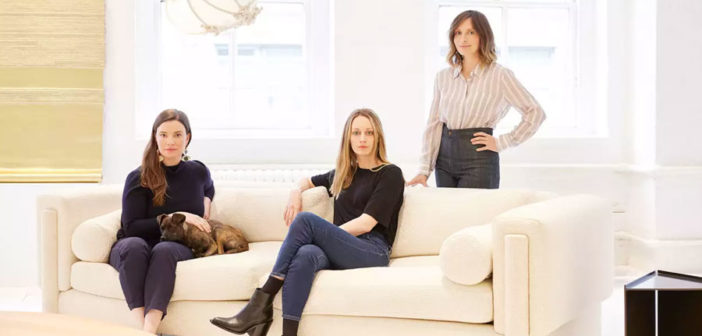“We exist, we’re powerful, we’re going to give each other a leg up.”
Coffee tables, sofas, and chandeliers may not seem like overtly political objects. But in Designing Women, a new exhibition curated by the New York design studio Egg Collective, they serve to illustrate that the social pathologies of gender inequity and gender bias are still ingrained in our culture–and in the design industry.
Every single piece in the show was designed and made by women, a testament to the strength, caliber, and diversity of work coming out of female-led studios today. However, put in today’s broader political context–from a misogynistic president to legislators waging war against reproductive rights–Designing Women is a potent reminder of how far women still need to go to achieve equality, both in design and the world at large.
When Egg Collective founders Crystal Ellis, Stephanie Beamer, and Hillary Petrie thought about what they wanted to produce for NYCxDesign, New York’s annual design festival, gender was top of mind. “There’s something in the collective conscious right now about the direction the country is going and not wanting it to slip backward,” Ellis says. “Women in the design industry are still a minority, especially women such as those in the show who are fabricating and designing . . . We exist, we’re powerful, we’re going to give each other a leg up.”
I spoke to four women featured in the show, all of whom are designers and own their businesses, about how gender bias and sexism has impacted their work. What did I hear? That while artists and designers as a group tend to be fairly progressive, the industry is far from immune to gender bias and inequity–it just manifests in nuanced ways.

“I WAS INCLUDED IN SHOWS BECAUSE THEY ‘NEEDED A WOMAN.’”
“The spirit of the 1960s and ’70s are back,” says Lindsey Adelman, a lighting designer featured in the exhibition. “It’s great to celebrate how far women have come in history while revisiting what seems to still need attention and energy.”
Adelman’s lighting–sculptural compositions of mouth-blown glass and metals like brass and bronze–is coveted internationally. She’s the most prominent of the 15 designers in the show, and she has experienced both positive and negative impacts related to design’s gender imbalance. In at least one way, the underrepresentation of women in design actually helped her business. “I certainly haven’t experienced discrimination and bias in a negative way,” Adelman says. “I was included in shows because they ‘needed a woman.’ It’s worked in my favor.”
Over the past few years, Adelman has noticed a shift in how female designers are discussed. More women in New York are running their own businesses and operating as sole proprietors, whereas a decade ago, women designers often worked within a couple and were discussed in that context–as part of a partnership. Additionally, the type of design work for which women are recognized has changed. “Through history you’d see women associated with textiles, jewelry, and small-scale design,” she says. “These days you see women in metal shops, glass-blowing studios, woodshops, and it doesn’t feel like an anomaly.”
Adelman calls herself an “eternal optimist,” and sees advantages for women designers today–specifically that there is a growing market of female collectors and clients. She admires the confidence she sees in twentysomething designers, too, which wasn’t necessarily there when her generation was coming up. “It’s a great time to be female in design,” she says.

“IT’S A ‘GIRLS AREN’T GOOD AT SCIENCE’ BIAS.”
Lighting designer Bec Brittain became design director in Adelman’s studio in 2008 and cast out on her own in 2011. She focuses on designing lighting systems that can be custom configured–a reflection of her training as an architect. Like most of the designers I spoke with, she’s experienced gender bias in the context of manufacturing.
“Beyond how living in a patriarchal world can be a bummer, my female team members and I need to be three times more knowledgeable about manufacturing [than men],” she says. “If we’re talking to a machinist or a plater, we’re bumping up against their bias that we don’t know how to make stuff. It’s a ‘girls aren’t good at science’ bias. It’s not specific to design, but it’s something we run into.”
She points out instances where she’s been on long phone calls with a machinist trying to solve a problem, but then when a male member of her team gets on the line, “it’s smooth sailing,” she says. “I get those glimpses into how things aren’t the same.”
As challenging and frustrating as the instances of bias are in the design world, she argues that they’re symptomatic of deeper cultural problems. “I don’t think design, specifically, is any worse than the rest of our society right now,” she says. “While I would be happy to talk about my own brand of feminism, it’s not design specific; it’s about what we as a culture need to do to respect women.”
Additionally, Brittain points out that there are just some facts of life that make it difficult to find work-life balance. She had a baby a year ago, which was a challenge; she took a couple weeks off and hosted an exhibition when her son was eight weeks old. “There’s no maternity leave,” she says. “No one can substitute for the business owner for three months.”

“AS WOMEN, WE’RE TAUGHT TO BE MORE LOW-KEY AND DEMURE.”
Lora Appleton–founder of Kinder Modern, a boutique and gallery that sells vintage design for children and also its own line of contemporary pieces–notices gender bias manifesting most notably in the media. “There are a ton of amazing women, they’re just not talked about in a big way,” she says. “How many articles on Patricia Urquiola do we need? We tend to focus on the few than the many.”
Before founding her company four years ago, Appleton worked as an art director in the advertising industry and ran her own branding agency. She suggests the reason that male designers receive more attention, and more brand partnerships, may be due to their propensity to speak about themselves more comfortably. “Women seem to be, and this is a generalization, head-down doing the work and not talking about the work,” she says. “As women, we’re taught to be more low-key and demure. It’s like learning to be more communicative and willing to show off.”
Recently, Appleton launched the Female Design Council, a professional group that’s still in its nascent stages, to help with the challenge of getting more representation for women practitioners.
“The thought process [behind the Female Design Council]was, how do we bolster our work through a difficult economic climate, how can we educate younger designers, how do we foster contacts, and how do we build strength through a tougher [political]time,” Appleton says.

“WE REALIZED WE HAD TO HAVE SOLIDARITY AGAIN.”
Yolande Batteau–owner of Callidus Guild, a studio that creates artisanal architectural surfaces–agrees that building a stronger network is essential for counteracting, and overcoming, the toxic politics and gender dynamics at play today. She mentions that coming to the exhibition and meeting women who were working in textile design, ceramics, carpentry, and metal craft was invigorating.
“You can name on one hand the women [in design]who are really influential, people like Ilse Crawford and Annabelle Selldorf,” she says. “There are literally hundreds of men you could name. So the higher you crawl up the ladder, the thinner the air. There are not as many women.”
Batteau, who is in her 40s and has been working in decorative art and architecture since the mid-’90s, and has experienced different waves of feminism in her career, particularly the “women can have it all” mentality that is prevalent. “Instead of more equality, you got more work,” she says. “The responsibility doubled, but the share did not double.”
“This show was organized because of what’s going on in the world, and it’s a protest,” she adds. “We’re talking about basic human rights again. Women in the bubble of New York City feel terrified by the direction the country is going. We realized we had to have solidarity again. There was solidarity through the show. It’s talking about a big thing through a little thing.”
The designers I spoke with shared a few common suggestions for improving things, most of which revolved around education. In the early years, we need to encourage girls to work with their hands and make technical tools available to them. In secondary schools and at the college level, it’s about integrating discussions about gender equity and bias into coursework. For professional designers, it’s building a supportive network where female designers can look to for advice and boost each other up. In a way, Designing Women became a means to this end, as the curatorial process helped bring female practitioners in the city together.
In fact, Egg Collective’s show isn’t the only NYCxDesign exhibition focused solely on female designers. Chamber, a Chelsea gallery that exhibits conceptual design and architecture, also staged an exhibition from an all-female roster of artists called Room with Its Own Rules. In her curatorial statement, Matylda Krzykowski says the exhibition “is an example of what is clearly not yet happening. It presents a parallel, post-patriarchal reality in which an all-female show is a normal phenomenon, rather than a specially planned ‘affirmative action.’”
The fact that we’re living in 2017 and women still have to say “me too” is frustrating. But it’s exhibitions like these that are paving the way for a future where that won’t be the case.
–
This article first appeared in www.fastcodesign.com
Seeking to build and grow your brand using the force of consumer insight, strategic foresight, creative disruption and technology prowess? Talk to us at +9714 3867728 or mail: info@groupisd.com or visit www.groupisd.com




